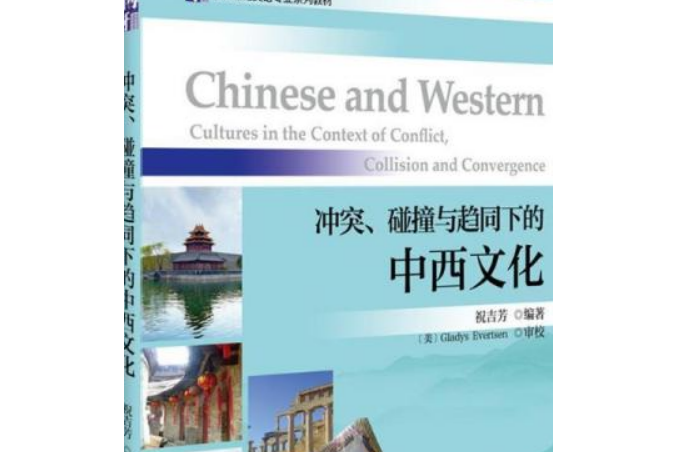《衝突、碰撞與趨同下的中西文化》是2016年出版的圖書,作者是祝吉芳。
基本介紹
- 中文名:衝突、碰撞與趨同下的中西文化
- 作者:祝吉芳
- 出版時間:2016年8月11日
- 頁數:324 頁
- ISBN:9787301272718
- 類別:文化交流
- 定價:45 元
- 開本:16 開
- 裝幀:平裝
- 版次:1
- 叢書系列: 21世紀英語專業系列教材
內容簡介,圖書目錄,作者簡介,
內容簡介
在客觀再現中西方學者有關中西方文化差異研究成果的基礎上,本教材具體內容以近年來的大量跨文化交流案例為橫線,以下述五個部分的內容為縱線,全面而審慎地展開:中西文化對比的意義; 無聲語言與文化差異;思維與文化差異;價值觀與文化差異;文化本位差異。 視野較寬:21世紀的英語教學不應僅局限於語言層面,應該把視野擴大到文化層面,因此本教材還強調文化差異意識及敏感性的培養。 涉及面廣:本教材綜合了英漢語言學、翻譯學、文化學、文化交流學、人類學、史學等學科知識,比同類教材更重視學生對所學知識的綜合運用。
圖書目錄
Contents
Foreword…1
Part I East and West
Unit 1 Why Contrasting Chinese and Western Cultures?…2
I. Ancient Civilizations and Cultures…2
II. Cross-cultural Comparative Studies in China…4
III. Imperatives to Contrast Chinese and Western Cultures…7
IV. A Note on Some Key Concepts…11
Unit 2 Traditional Characteristics of Chinese and Western Cultures…14
I. “There Are All Kinds of Birds When a Forest Gets Large”…15
II. Traditional Chinese Cultural Characteristics…17
III. Traditional Western Cultural Characteristics…24
Unit 3 Affinities across Cultures…29
I. An Unexpected Affinity…30
II. Reading for More Cultural Affinities…30
III. A Note on Some Key Concepts…38
Part II Cultural Differences in Silent Languages
Unit 4 Time…43
I. Time in China and the West…44
II. Two Time Modes…48
III. Past-oriented Societies vs. Future-oriented Societies…54
IV. Two Time Orientations…57
Unit 5 Space…61
I. Spatial Language…62
II. Spatial Language and Culture…65
III. Spatial Language and Life…71
IV. Changes We Cannot Afford…73
Unit 6 Smiles, Nods and Silence…75
I. Smiles…75
II. Nods in the Intercultural Communication…80
III. Silence in the Intercultural Communication…82
Part III Cultural Differences in Thinking
Unit 7 Intuitive vs. Logical Thinking…89
I. Definitions of Intuitive and Logical Thinking…89
II. Philosophy and Thinking…90
III. Application of the Two Thinking Modes…94
IV. Impact of Thinking Modes on Writings…98
V. Logic in China and Intuition in the West…100
Unit 8 Dialectical vs. Analytical Reasoning…104
I. Proverb Preferences across Cultures…104
II. Dialectical Reasoning…105
III. Analytical Reasoning…109
IV. More about the Two Reasoning Modes…113
Unit 9 Holistic vs. Atomistic Visions…116
I. A Detention Room Incident…116
II. Prominent Attributes of Holistic and Atomistic Visions…117
III. Vision and Cognition…122
IV. Vision and Language…123
V. Zhengshan Xiaozhong and Lipton Black Tea…128
Unit 10 Categorizing Objects by Relationships vs. by Attributes…131
I. Two Ways to Categorize One Person…132
II. Principles to Categorize Objects…133
III. How to Categorize Objects and Why…135
IV. Impacts of Different Ways of Categorization…137
V. Causal Attribution Differences Out of Different Categorization Ways…140
Unit 11 Non-controllers vs. Controllers…143
I. Too Early to Tell…144
II. Why So Different Stances towards Life…144
III. “Being” and “Doing” Cultures…149
IV. Manifestations of “Being” Culture and “Doing” Culture…153
Part IV Different Cultural Orientations
Unit 12 The Introvert-oriented vs. the Extrovert-oriented…160
I. Personality Types…160
II. Personality Types of Cultures…162
III. Effects of Personality Types on Pattern Preferences…166
IV. A Contrast of Cultural Phenomena…171
V. The Trend of the Introvert-oriented Chinese Culture…175
Unit 13 Collectivism vs. Individualism…177
I. An Embarrassing Habit…177
II. Collectivism and Individualism as Cultural Orientations…179
III. Collectivism and Individualism in Cultural Anthropology…183
IV. Collectivist and Individualist Perspectives of “Self”…185
V. Interdependence vs. Independence…189
Unit 14 Femininity vs. Masculinity…193
I. Gender Traits…193
II. Feminine Chinese Culture…195
III. Masculine Western Culture…201
IV. Why So Different?…205
V. The Trend of Cultures and Its Potential Impact…208
Unit 15 Advocacy of Jing vs. Dong…211
I. Introduction to Two Concepts…211
II. Jing Advocacy of China…213
III. Dong Advocacy of the West…221
IV. Differences and Discomforts…225
Unit 16 Implicitness vs. Explicitness…229
I. “Half a Story”…229
II. Implicitness and Explicitness of Language…231
III. Implicit Chinese…234
IV. Explicit Westerners…241
V. High Context vs. Low Context…244
VI. “Chicken and Duck Talk”…247
Part V Different Cultural Standards
Unit 17 Peace vs. Conflict…253
I. Great Names and Different Cultural Standards…253
II. External Factors and Cultural Standards…258
III. Cultural Standards and Their Unique Products…260
IV. Better Ways to Know Each Other…265
Unit 18 Egalitarian and Inegalitarian Distribution…268
I. Hate-the-rich Mentality…268
II. Chinese-style Egalitarianism…269
III. Western-style Inegalitarianism…272
IV. Egalitarianism and Inegalitarianism in China and the West…274
Unit 19 Good vs. Evil Human Nature…279
I. Definitions of Key Concepts…280
II. Human Nature and Education…281
III. Theorization of Assumptions about Human Nature…283
IV. Human Nature Theories and the Rule of Ethics vs. Law…288
Unit 20 Rule of Individuals vs. Rule of Law…290
I. An Unexpected Complaint…290
II. Rule of Individuals in Traditional Chinese Thought…291
III. Rule of Law in Western Thought…296
IV. Rule of Law in China…30 Bibliography…305
作者簡介
河海大學外語學院教授,2001年南京大學博士畢業,全英文獨撰作品2部,主編教材9部,其中《英漢翻譯:方法與試筆》在我社出版;漢譯英作品3部,英譯漢作品8部,研究主持科研10項

